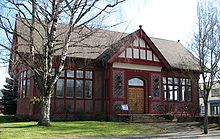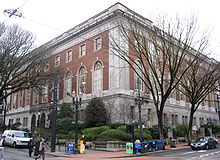- Multnomah County Library
-
Multnomah County Library 
Established 1864 Location Multnomah County, Oregon Coordinates 45°31′8″N 122°40′59″W / 45.51889°N 122.68306°WCoordinates: 45°31′8″N 122°40′59″W / 45.51889°N 122.68306°W Branches 19 Collection Size 1,994,641 Access and use Circulation 22,715,292 Population served 724,680 Members 425,749 Other information Budget $61 million Director Vailey Oehlke Staff 495 FTE Website www.multcolib.org Multnomah County Library is a public library system serving Multnomah County, Oregon, United States. Started in 1864, the system has 19 library locations with books, magazines, DVDs, and computers. It is the largest library system in Oregon serving a population of 724,680, with more than 425,000 registered borrowers.[1] According to the Public Library Association, it ranks second among U.S. libraries, based on circulation of books and materials, and ranks first among libraries serving fewer than one million residents. In this respect, it is the busiest in the nation.[2]
Contents
History
After Leland H. Wakefield began collecting funds door-to-door in 1863, the Mercantile Library Association was started on January 12, 1864, with subscriptions by Portland's merchant elite.[3][4] Judge Matthew Deady was one of the early founders, with financial support coming from those such as Henry Corbett, William S. Ladd, and Erasmus D. Shattuck among others.[4] The more inclusive Library Association of Portland name was chosen, likely on Judge Deady's suggestion.[3][4] The founders proclaimed "the library should forever be kept free of politics."[3]
By March 1864, there were 153 members, who had subscribed $2,500, and Ladd was elected president.[3] Harvey W. Scott served as the first librarian, part-time, at its first location on Stark Street in Portland.[3][4] In 1869, the library moved to the Ladd & Tilton Bank Building where it received free rent.[4] Deady was the president from 1874 until 1893, and found that fundraising was "like pulling teeth", calling the local establishment "closefisted narrow visioned millionaires" in 1888, also stating "The rich men of Portland will never do much for [the library] until they die, and maybe not then."[3] The first major bequest came from Stephen Skidmore in 1883.[3]
In 1891, a new separate library, the Portland Public Library, was founded by a group that included some former LAP board members.[5] The two libraries would merge in 1902.[5]
The library moved to a new two-story stone library building in 1891 at Broadway and Stark streets.[3][4] This building cost $156,477 to build, representing 27 years of fundraising, mostly by Deady.[3][4] It was staffed by D. F. W. Bursch, the library's first trained librarian,[4] and contained 20,000 volumes.[3] A large source of the funds came from the estate of Ella M. Smith, daughter of Benjamin F. Smith, in 1889.[5] Bursch would oversee the implementation of the Dewey decimal system at the library.[4]
Prior to becoming a free public library, the board tried to lower subscription costs as often as possible to allow a larger percentage of the general public to have access to the resource.[5] The board debated whether to become a government supported library, with longtime board member Matthew Deady arguing against government support as it might lead to the library being a politically charged entity.[5] In 1897, president of the board George Henry Williams proposed some censorship on the collections of the library.[5]
The library declined an offer of a $100,000 donation from Andrew Carnegie in 1901, but did receive $105,000 in 1911 and $60,000 in 1912 to build branch locations.[5] The library received nearly 9,000 books in 1900 from the estate of John Wilson, many of these were rare books.[5] However, the bequest called for the books to be available free of charge to the public, thus the board voted to provide library services to the public under government contract.[5] In 1901, the state passed a law to allow governments to tax citizens to pay for libraries.[5] The city of Portland and the library entered into a contract where the privately owned library continued to own its collection, but the city paid for services, thus creating a free publicly supported library.[5] In January 1901, the library allowed books to circulate for the first time.[5]
Opened on March 16, 1902, it was the first free library in the state paid for by taxes.[5] At that time it features more than 38,000 volumes and 215 periodicals.[5] In 1913, the Library Association of Portland (LAP) built the Central Library in downtown Portland at Tenth Street.[5] They did not use any Carnegie funds for the project, instead financing came from a special two-year tax.[4][5]
On July 1, 1990, the LAP officially transferred ownership of the library buildings and collections to Multnomah County.[6]
Branches
The Multnomah County Library operates a Central Library in downtown Portland and 18 branches: Gresham, Albina, Woodstock, St. Johns, Rockwood, North Portland, Kenton, Northwest, Sellwood-Moreland, Troutdale, Fairview-Columbia, Capitol Hill, Belmont, Midland, Hollywood, Holgate, Gregory Heights, and Hillsdale.[1] Midland is the largest of these branch locations with a total of 25,000 square feet (2,300 m2) followed by the Gresham location with 20,000 square feet (1,900 m2).[1] The St. Johns and North Portland branches are both Carnegie libraries. (There were also five Carnegie libraries no longer part of the system: Albina (old), Arleta, East Portland, Gresham (old), and South Portland).[7]
Central Library
The Central Library in downtown Portland serves as the main branch of the system. The building was designed by architect A. E. Doyle, and opened on September 6, 1913.[8] It was one of the first libraries in the United States to feature an open-plan.[9] The three-story Central Library was listed on the National Register of Historic Places as the Central Building, Public Library in 1979.[10] It contains 17 miles (27 km) of bookshelf space and has more than 130 computers for the public. The branch contains 125,000 square feet (11,600 m2) of space.[1]
Details
As of FY2010, the system has a total of 486 FTE employees, including 91 librarian FTE.[1] Total annual revenue was just over $62.8 million, with expenditures of $60.5 million.[1] There are more than 425,000 library card holders in the system that serves a population of over 700,000 people, the largest in the state. Multnomah County Library has a total of 1,994,541 books, DVDs, CDs, periodicals, and other library materials.[1] There was a total of 5,799,497 visits in FY2010 with the total circulation of 22,715,292.[1] The library system contains a total of about 700 computer search stations for the public and a combined total of 277,762 square feet (25,804.9 m2) of space at all 19 libraries.[1]
See also
References
- ^ a b c d e f g h i Orregon Public Library Statistics. [http://www.oregon.gov/osl/ls/statsploregon.shtml Oregon State Library. Retrieved on Feb. 9, 2011.
- ^ Press release from Queens Library, August 2008. Retrieved on July 2, 2009. Original data from Public Library Data Service Statistical Report 2008. Chicago: PLA, 2008.
- ^ a b c d e f g h i j MacColl, E. Kimbark. The Growth of a City: Power and Politics in Portland, Oregon 1915-1950. Portland, Oregon: The Georgian Press. p. 108. ISBN 0960340815.
- ^ a b c d e f g h i j Corning, Howard M. (1989) Dictionary of Oregon History. Binfords & Mort Publishing. p. 147-8.
- ^ a b c d e f g h i j k l m n o p Gunselman, Cheryl. Pioneering Free Library Service for the City, 1864-1902: The Library Association of Portland and the Portland Public Library. Oregon Historical Quarterly, September 22, 2002. Pg. 320 Vol. 103 No. 3 ISSN 0030-4727
- ^ About the library: History. Multnomah County Library. Retrieved on March 13, 2008.
- ^ Carnegie Public Libraries in Oregon. OLA Quarterly, Volume 2, Number 1 — Spring 1996. Oregon Library Association. Retrieved on March 16, 2008.
- ^ Central Library. Multnomah County Library. Retrieved on March 16, 2008.
- ^ Gragg, Randy. Recycling the Armory. The Oregonian, September 24, 2006.
- ^ "Oregon National Register List". Oregon State Parks and Recreation Department. July 16, 2007. http://www.oregon.gov/OPRD/HCD/NATREG/docs/oregon_nr_list.pdf. Retrieved 2008-03-10.
Further reading
- Anderson, Katherine E. Historical Sketch of the Library Association of Portland, 1864-1964. Portland: The Library Association, 1964.
- Richard E. Ritz, Central Library: Portland's Crown Jewel. Portland: The Library Association, 2000. ISBN 0-9674860-0-9
External links
Categories:- Education in Portland, Oregon
- Education in Multnomah County, Oregon
- Public libraries in Oregon
- Carnegie libraries in Oregon
- Buildings and structures in Multnomah County, Oregon
Wikimedia Foundation. 2010.


